Citroen C4 DAG 2014.5 2.G Owner's Manual
Manufacturer: CITROEN, Model Year: 2014.5, Model line: C4 DAG, Model: Citroen C4 DAG 2014.5 2.GPages: 340, PDF Size: 12.89 MB
Page 181 of 340
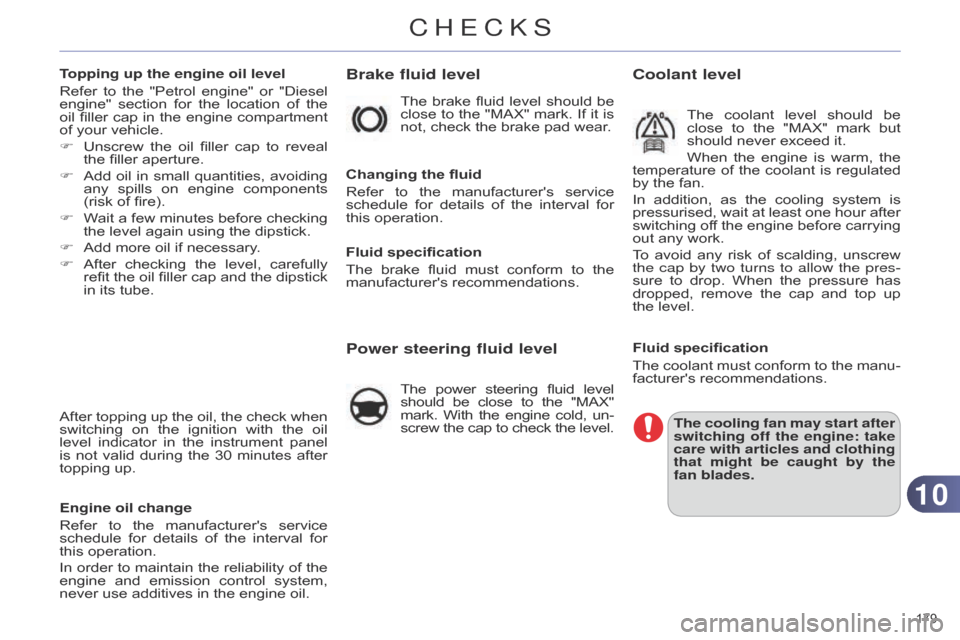
1010
179
C4-2_en_Chap10_verification_ed01-2014
Brake fluid level
Changing the fluid
Refer
to
the
manufacturer's
service
schedule
for
details
of
the
interval
for
this
operation.
Fluid specification
The
brake
fluid
must
conform
to
the
manufacturer's
recommendations.
Power steering fluid level
The power steering fluid level should
be close to the "MAX" mark.
With
the
engine
cold,
un
-
screw
the
cap
to
check
the
level.
Coolant level
The coolant level should be close
to the "MAX" mark but
should
never exceed it.
When
the
engine
is
warm,
the
temperature
of
the
coolant
is
regulated
by
the
fan.
In
addition,
as
the
cooling
system
is
pressurised,
wait
at
least
one
hour
after
switching
of
f
the
engine
before
carrying
out
any
work.
To
avoid
any
risk
of
scalding,
unscrew
the cap by two turns to allow the pres
-
sure
to
drop.
When
the
pressure
has
dropped,
remove
the
cap
and
top
up
the
level.
Fluid specification
The
coolant
must
conform
to
the
manu
-
facturer's
recommendations.
The cooling fan may start after
switching off the engine: take
care with articles and clothing
that might be caught by the
fan blades.
The
brake
fluid
level
should
be
close
to
the
"MAX"
mark.
If
it
is
not,
check
the
brake
pad
wear.
Topping up the engine oil level
Refer
to
the
"Petrol
engine"
or
"Diesel
engine"
section
for
the
location
of
the
oil
filler
cap
in
the
engine
compartment
of
your
vehicle.
F
Unscrew
the
oil
filler
cap
to
reveal
the
filler
aperture.
F
Add
oil
in
small
quantities,
avoiding
any
spills
on
engine
components
(risk
of
fire).
F
W
ait
a
few
minutes
before
checking
the
level
again
using
the
dipstick.
F
Add
more
oil
if
necessary.
F
After
checking
the
level,
carefully
refit
the
oil
filler
cap
and
the
dipstick
in
its
tube.
After
topping
up
the
oil,
the
check
when
switching
on
the
ignition
with
the
oil
level
indicator
in
the
instrument
panel
is
not
valid
during
the
30
minutes
after
topping
up.
Engine oil change
Refer
to
the
manufacturer's
service
schedule
for
details
of
the
interval
for
this
operation.
In
order
to
maintain
the
reliability
of
the
engine
and
emission
control
system,
never
use
additives
in
the
engine
oil.
CHECKS
Page 182 of 340
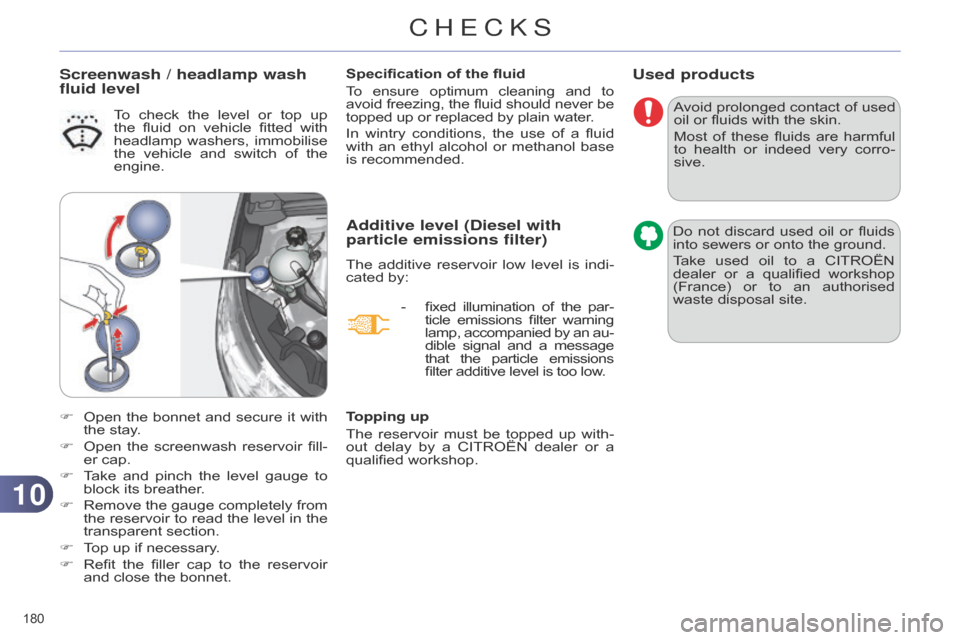
1010
180
C4-2_en_Chap10_verification_ed01-2014
Used products
Avoid prolonged contact of used oil
or fluids with the skin.
Most
of
these
fluids
are
harmful
to
health
or
indeed
very
corro
-
sive.
Do
not
discard
used
oil
or
fluids
into
sewers or onto the ground.
Take
used
oil
to
a
CITROËN
dealer
or
a
qualified
workshop
(France)
or
to
an
authorised
waste
disposal site.
Additive level (Diesel with
particle emissions filter)
The additive reservoir low level is indi -
cated by:
Topping up
The
reservoir
must
be
topped
up
with
-
out
delay
by
a
CITROËN
dealer
or
a
qualified
workshop.
-
fixed
illumination
of
the
par
-
ticle
emissions
filter
warning lamp,
accompanied
by
an
au
-
dible
signal
and
a
message that
the
particle
emissions filter
additive level is too low.
Screenwash / headlamp wash
fluid levelSpecification of the fluid
To
ensure
optimum
cleaning
and
to avoid
freezing,
the
fluid
should
never
be topped
up or replaced by plain water.
In
wintry
conditions,
the
use
of
a
fluid
with
an
ethyl
alcohol
or
methanol
base
is
recommended.
To
check
the
level
or
top
up
the
fluid
on
vehicle
fitted
with
headlamp
washers,
immobilise
the
vehicle
and
switch
of
the
engine.
F
Open
the
bonnet
and
secure
it
with
the
stay.
F
Open
the
screenwash
reservoir
fill
-
er
cap.
F
T
ake
and
pinch
the
level
gauge
to
block
its
breather.
F
Remove
the
gauge
completely
from
the
reservoir
to
read
the
level
in
the
transparent
section.
F
T
op
up
if
necessary.
F
Refit
the
filler
cap
to
the
reservoir
and
close
the
bonnet.
CHECKS
Page 183 of 340
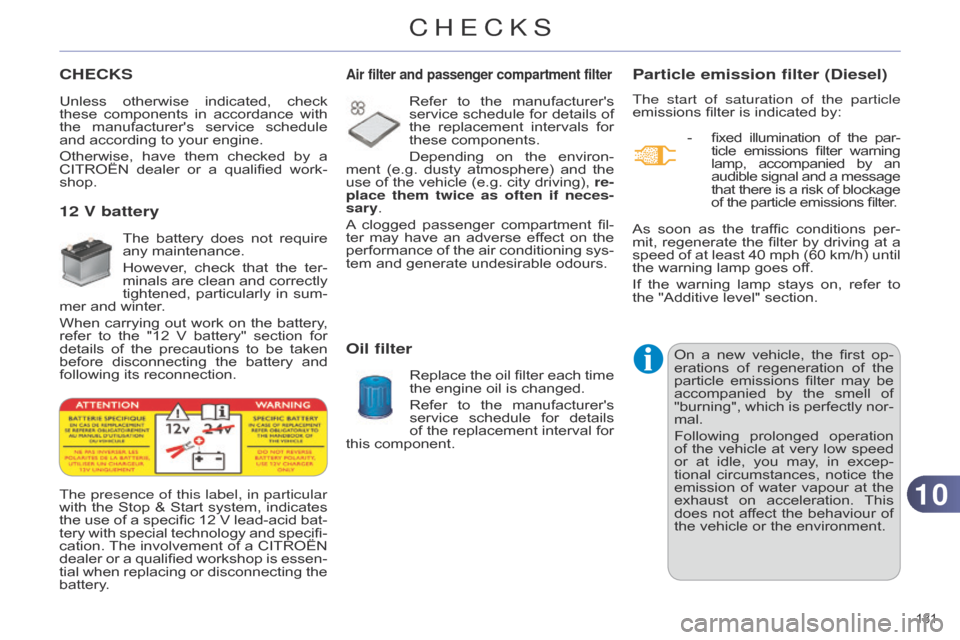
1010
181
C4-2_en_Chap10_verification_ed01-2014
CHECKSParticle emission filter (Diesel)
The start of saturation of the particle
emissions filter is indicated by:
-
fixed
illumination
of
the
par
-
ticle
emissions
filter
warning lamp,
accompanied
by
an audible
signal
and
a
message that
there
is
a
risk
of
blockage of
the particle emissions filter.
The presence of this label, in particular
with
the
Stop
&
Start
system,
indicates
the
use
of
a
specific
12
V
lead-acid
bat
-
tery
with
special
technology
and
specifi
-
cation.
The
involvement
of
a
CITROËN
dealer
or
a
qualified
workshop
is
essen
-
tial
when
replacing
or
disconnecting
the
battery
. On
a
new
vehicle,
the
first
op
-
erations
of
regeneration
of
the
particle
emissions
filter
may
be
accompanied
by
the
smell
of
"burning",
which
is
perfectly
nor
-
mal.
Following
prolonged
operation
of
the
vehicle
at
very
low
speed
or
at
idle,
you
may
,
in
excep
-
tional
circumstances,
notice
the
emission
of
water
vapour
at
the
exhaust
on
acceleration.
This
does
not
af
fect
the
behaviour
of
the
vehicle or the environment.
As
soon
as
the
traffic
conditions
per
-
mit,
regenerate
the
filter
by
driving
at
a
speed
of
at
least
40
mph
(60
km/h)
until
the
warning lamp goes off.
If
the
warning
lamp
stays
on,
refer
to
the
"Additive level" section.
Unless
otherwise
indicated,
check
these
components
in
accordance
with
the
manufacturer's
service
schedule
and
according
to
your
engine.
Otherwise,
have
them
checked
by
a
CITROËN
dealer
or
a
qualified
work
-
shop.
Air filter and passenger compartment filter
Refer to the manufacturer's service
schedule for details of
the
replacement
intervals
for
these
components.
Depending
on
the
environ
-
ment
(e.g.
dusty
atmosphere)
and
the
use
of
the
vehicle
(e.g.
city
driving),
re
-
place them twice as often if neces-
sary.
A
clogged
passenger
compartment
fil
-
ter
may
have
an
adverse
ef
fect
on
the
performance
of
the
air
conditioning
sys
-
tem
and
generate undesirable odours.
Oil filter
Replace the oil filter each time the
engine oil is changed.
Refer
to
the
manufacturer's
service
schedule
for
details
of
the
replacement
interval
for
this
component.
12 V battery
The battery does not require any
maintenance.
However,
check
that
the
ter
-
minals
are
clean
and
correctly
tightened,
particularly
in
sum
-
mer
and
winter.
When
carrying
out
work
on
the
battery
,
refer
to
the
"12
V
battery"
section
for
details
of
the
precautions
to
be
taken
before
disconnecting
the
battery
and
following
its reconnection.
CHECKS
Page 184 of 340
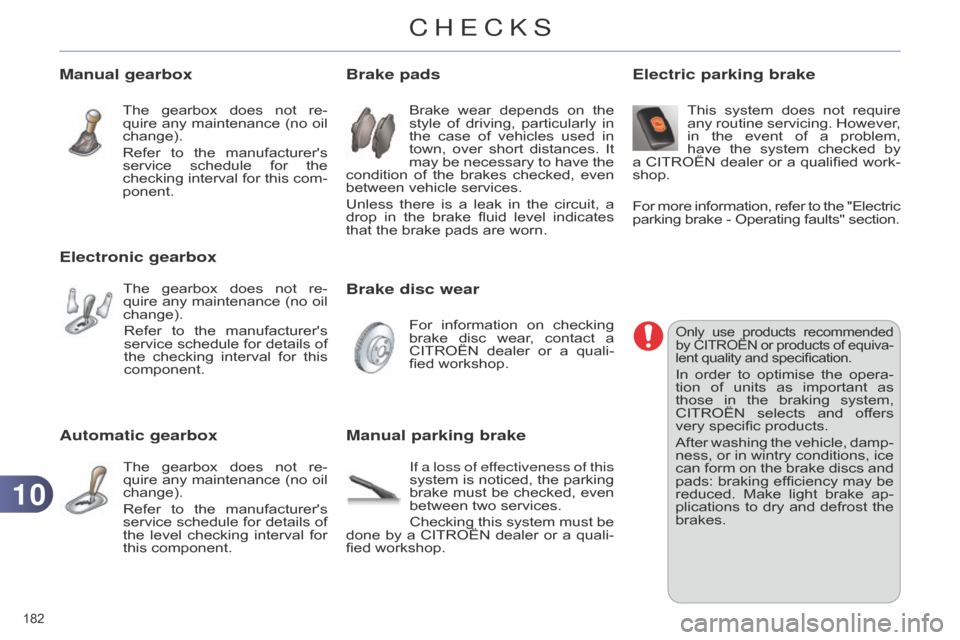
1010
182
C4-2_en_Chap10_verification_ed01-2014
Automatic gearbox
The gearbox does not re -
quire any maintenance (no oil
change).
Refer
to
the
manufacturer's
service
schedule
for
details
of
the
level
checking
interval
for
this
component.
Electric parking brake
This system does not require any
routine servicing. However ,
in
the
event
of
a
problem,
have
the
system
checked
by
a
CITROËN
dealer
or
a
qualified
work
-
shop.
Manual parking brake
Only use products recommended by
CITROËN or products of equiva -
lent
quality and specification.
In order to optimise the opera -
tion of units as important as
those
in
the
braking
system,
CITROËN
selects
and
of
fers
very
specific products.
After
washing
the
vehicle,
damp
-
ness,
or
in
wintry
conditions,
ice
can
form
on
the
brake
discs
and
pads:
braking
efficiency
may
be
reduced.
Make
light
brake
ap
-
plications
to
dry
and
defrost
the
brakes.
If a loss of ef
fectiveness of this
system
is
noticed,
the
parking
brake
must
be
checked,
even
between
two
services.
Checking
this
system
must
be
done
by
a
CITROËN
dealer
or
a
quali
-
fied
workshop.
Brake pads
Brake wear depends on the style
of driving, particularly in
the
case
of
vehicles
used
in
town,
over
short
distances.
It
may
be
necessary
to
have
the
condition
of
the
brakes
checked,
even
between
vehicle services.
Unless
there
is
a
leak
in
the
circuit,
a
drop
in
the
brake
fluid
level
indicates
that
the
brake pads are worn.
Brake disc wear
For information on checking brake
disc wear , contact a
CITROËN
dealer
or
a
quali
-
fied
workshop. For
more
information,
refer
to
the
"Electric parking
brake - Operating faults" section.
Manual gearbox
The gearbox
does not re -
quire any maintenance (no oil
change).
Refer
to
the
manufacturer's
service
schedule
for
the
checking
interval
for
this
com
-
ponent.
Electronic gearbox
The gearbox does not re -
quire any maintenance (no oil
change).
Refer
to
the
manufacturer's
service
schedule
for
details
of
the
checking
interval
for
this
component.
CHECKS
Page 185 of 340
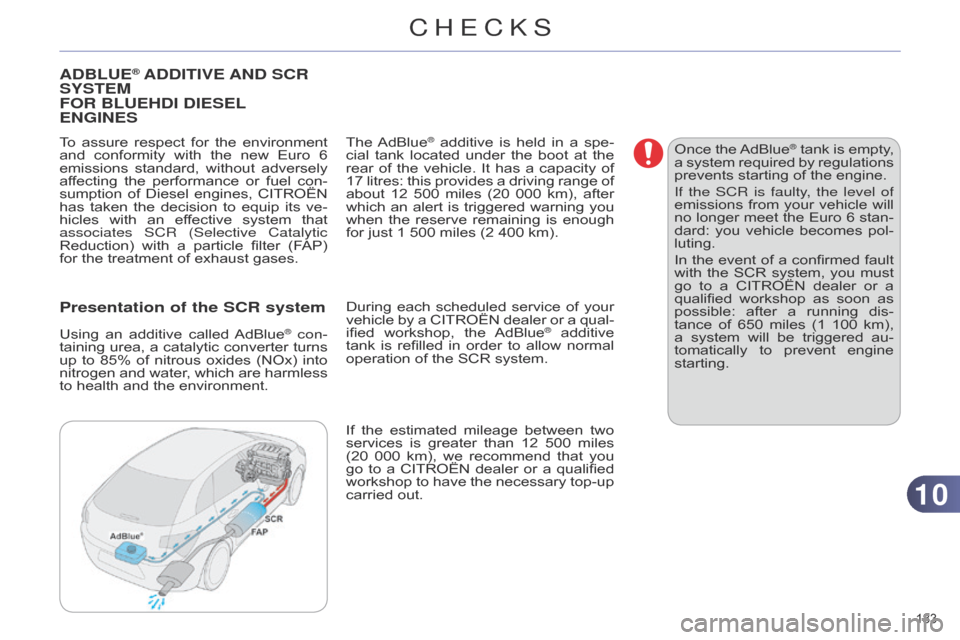
1010
183
C4-2_en_Chap10_verification_ed01-2014
ADBLUE® ADDITIVE AND SCR SYSTEM
FOR
B
LUE HD I D IESEL
ENGINES
To assure respect for the environment and
conformity with the new Euro 6
emissions
standard,
without
adversely
af
fecting
the
performance
or
fuel
con
-
sumption
of
Diesel
engines,
CITROËN
has
taken
the
decision
to
equip
its
ve
-
hicles
with
an
ef
fective
system
that
associates SCR (Selective Catalytic
Reduction)
with
a
particle
filter
(F
AP)
for
the treatment of exhaust gases.
Presentation of the SCR system
Using an additive called AdBlue® con-
taining
urea,
a
catalytic
converter
turns
up
to
85%
of
nitrous
oxides
(NOx)
into
nitrogen
and
water
,
which
are
harmless
to
health
and
the
environment. The
AdBlue® additive
is held in a spe -
cial
tank
located under the boot at the
rear
of
the
vehicle.
It
has
a
capacity
of
17
litres:
this
provides
a
driving
range
of
about
12
500
miles
(20
000
km),
after
which
an
alert
is
triggered
warning
you
when
the
reserve
remaining
is
enough
for
just
1
500 miles (2 400 km).
During
each
scheduled
service
of
your
vehicle
by
a
CITROËN
dealer
or
a
qual
-
ified
workshop,
the
AdBlue® additive tank
is
refilled
in
order
to
allow normal
operation
of
the
SCR
system.
If
the
estimated
mileage
between
two
services
is
greater
than
12
500
miles
(20
000
km),
we
recommend
that
you
go
to
a
CITROËN
dealer
or
a
qualified
workshop
to
have
the
necessary
top-up
carried
out. Once
the
AdBlue® tank is
empty , a
system
required
by regulations
prevents
starting
of the engine.
If the SCR
is faulty, the level of
emissions
from
your
vehicle
will
no
longer
meet
the
Euro
6
stan
-
dard:
you
vehicle
becomes
pol
-
luting.
In
the
event
of
a
confirmed
fault
with
the
SCR
system,
you
must
go
to
a
CITROËN
dealer
or
a
qualified
workshop
as
soon
as
possible:
after
a
running
dis
-
tance
of
650
miles
(1
100
km),
a
system
will
be
triggered
au
-
tomatically
to
prevent
engine
starting.
CHECKS
Page 186 of 340
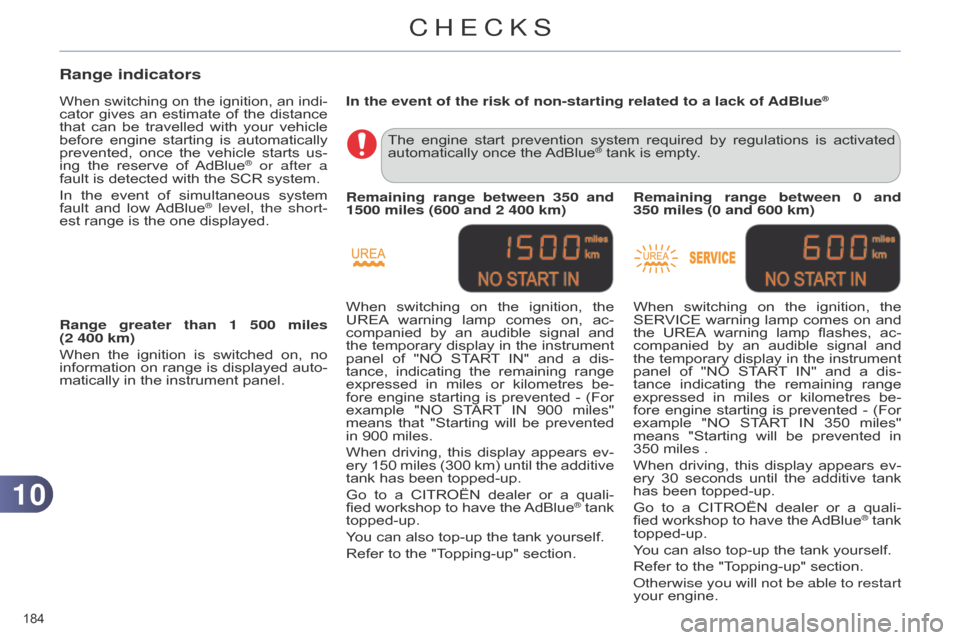
1010
184
C4-2_en_Chap10_verification_ed01-2014
Range indicators
When switching on the ignition, an indi -
cator gives an estimate of the distance
that
can
be
travelled
with
your
vehicle
before
engine
starting
is
automatically
prevented,
once
the
vehicle
starts
us
-
ing
the
reserve
of
AdBlue® or after a
fault
is
detected
with
the
SCR system.
In
the
event
of
simultaneous
system
fault
and
low
AdBlue® level, the short-
est
range
is
the
one
displayed. In the event of the risk of non-starting related to a lack of AdBlue
®
The engine
start prevention system required by regulations is activated automatically
once the AdBlue® tank is empty.
Range greater than 1 500 miles
(2
400 km)
When
the
ignition
is
switched
on,
no
information
on
range
is
displayed
auto
-
matically
in
the
instrument
panel. Remaining range between 350 and
1500 miles (600 and 2 400 km)
When
switching
on
the
ignition,
the
UREA warning
lamp
comes
on,
ac
-
companied
by
an
audible
signal
and
the
temporary
display
in
the
instrument
panel
of
"NO
ST
ART
IN"
and
a
dis
-
tance,
indicating
the
remaining
range
expressed
in
miles
or
kilometres
be
-
fore
engine
starting
is
prevented
-
(For
example
"NO
ST
ART
IN
900
miles"
means
that
"Starting
will
be
prevented
in
900
miles.
When
driving,
this
display
appears
ev
-
ery
150
miles
(300
km)
until
the
additive
tank
has
been
topped-up.
Go
to
a
CITROËN
dealer
or
a
quali
-
fied
workshop
to
have
the
AdBlue® tank topped-up.
Y
ou
can
also
top-up
the
tank
yourself.
Refer
to
the
"Topping-up"
section. Remaining range between 0 and
350
miles (0 and 600 km)
When
switching
on
the
ignition,
the
SER
VICE
warning
lamp
comes
on
and
the
UREA warning
lamp
flashes,
ac
-
companied
by
an
audible
signal
and
the
temporary
display
in
the
instrument
panel
of
"NO
ST
ART
IN"
and
a
dis
-
tance
indicating
the
remaining
range
expressed
in
miles
or
kilometres
be
-
fore
engine
starting
is
prevented
-
(For
example
"NO
ST
ART
IN
350
miles"
means
"Starting
will
be
prevented
in
350
miles .
When
driving,
this
display
appears
ev
-
ery
30
seconds
until
the
additive
tank
has
been topped-up.
Go to a CITROËN dealer or a quali -
fied workshop to have the AdBlue® tank topped-up.
Y
ou
can
also
top-up
the
tank
yourself.
Refer
to
the
"Topping-up"
section.
o
therwise you will not be able to restart
your
engine.
CHECKS
Page 187 of 340
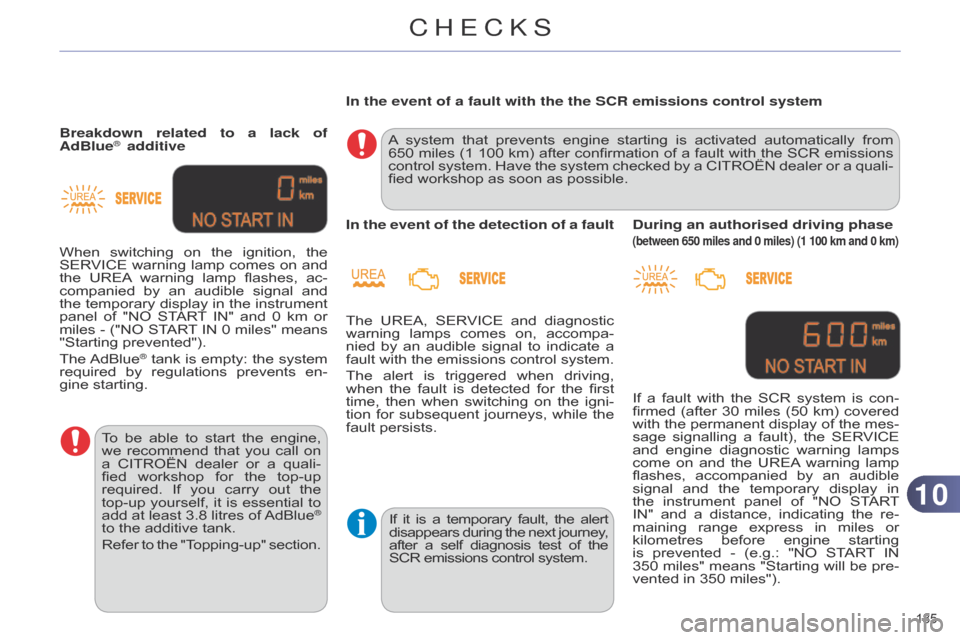
1010
185
C4-2_en_Chap10_verification_ed01-2014
Breakdown related to a lack of
AdBlue® additive
To
be
able
to
start
the
engine,
we
recommend
that
you
call
on
a
CITROËN
dealer
or
a
quali
-
fied
workshop
for
the
top-up
required.
If
you
carry
out
the
top-up
yourself,
it
is
essential
to
add
at
least
3.8
litres
of
AdBlue®
to
the
additive
tank.
Refer
to
the
"T
opping-up"
section.
When
switching
on
the
ignition,
the
SER
VICE
warning
lamp
comes
on
and
the
UREA warning
lamp
flashes,
ac
-
companied
by
an
audible
signal
and
the
temporary
display
in
the
instrument
panel
of
"NO
ST
ART
IN"
and
0
km
or
miles
-
("NO
ST
ART
IN
0
miles"
means
"Starting
prevented").
The
AdBlue® tank
is empty: the system required
by
regulations prevents en -
gine
starting. In the event of a fault with the the SCR emissions control system
A
system
that
prevents
engine
starting
is
activated
automatically
from
650
miles
(1
100
km)
after
confirmation
of
a
fault
with
the
SCR
emissions
control
system.
Have
the
system
checked
by
a
CITROËN
dealer
or
a
quali
-
fied workshop as soon as possible.
In the event of the detection of a fault
The
UREA,
SER
VICE
and
diagnostic
warning
lamps
comes
on,
accompa
-
nied by an audible signal to indicate a fault
with the emissions control system.
The
alert
is
triggered
when
driving,
when
the
fault
is
detected
for
the
first
time,
then
when
switching
on
the
igni
-
tion
for
subsequent
journeys,
while
the
fault
persists.
If
it
is
a
temporary
fault,
the
alert disappears
during
the
next
journey
,
after
a
self
diagnosis
test
of
the SCR
emissions control system.During an authorised driving phase
(between 650 miles and 0 miles) (1 100 km and 0 km)
If a
fault with the SCR system is con -
firmed (after 30 miles (50 km) covered
with
the
permanent
display
of
the
mes
-
sage
signallin
g
a
fault),
the
SER
VICE
and
engine
diagnostic
warning
lamps
come
on
and
the
UREA warning
lamp
flashes,
accompanied
by
an
audible
signal
and
the
temporary
display
in
the
instrument
panel
of
"NO
ST
ART
IN"
and
a
distance,
indicating
the
re
-
maining
range
express
in
miles
or
kilometres
before
engine
starting
is
prevented
-
(e.g.:
"NO
ST
ART
IN
350
miles"
means
"Starting
will
be
pre
-
vented
in 350 miles").
CHECKS
Page 188 of 340
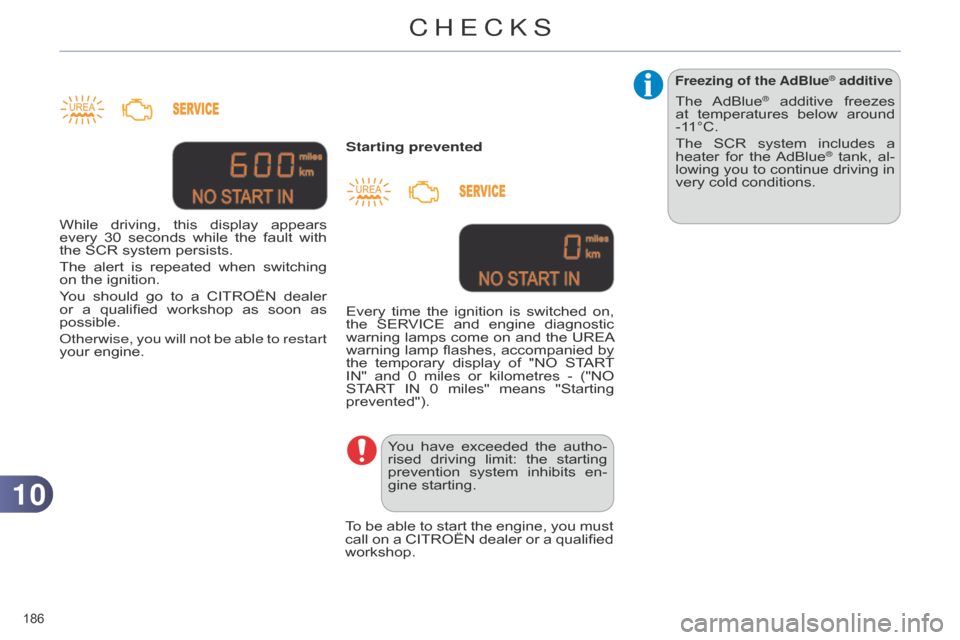
1010
186
C4-2_en_Chap10_verification_ed01-2014
Starting preventedYou
have
exceeded
the
autho
-
rised
driving
limit:
the
starting
prevention
system
inhibits
en
-
gine
starting.
Every
time
the
ignition
is
switched
on,
the
SER
VICE
and
engine
diagnostic
warning
lamps
come
on
and
the
UREA warning
lamp
flashes,
accompanied
by
the
temporary
display
of
"NO
ST
ART
IN"
and
0
miles
or
kilometres
-
("NO
ST
ART
IN
0
miles"
means
"Starting
prevented").
T
o
be
able
to
start
the
engine,
you
must
call
on
a
CITROËN
dealer
or
a
qualified
workshop.
Freezing of the AdBlue® additive
The AdBlue® additive freezes at
temperatures below around
-1
1°C.
The
SCR
system
includes
a
heater
for
the
AdBlue® tank, al-
lowing
you
to
continue
driving in
very
cold
conditions.
While
driving,
this
display
appears
every
30
seconds
while
the
fault
with
the
SCR
system
persists.
The
alert
is
repeated
when
switching
on
the
ignition.
You
should
go
to
a
CITROËN
dealer
or
a
qualified
workshop
as
soon
as
possible.
o
therwise, you will not be able to
restart
your
engine.
CHECKS
Page 189 of 340
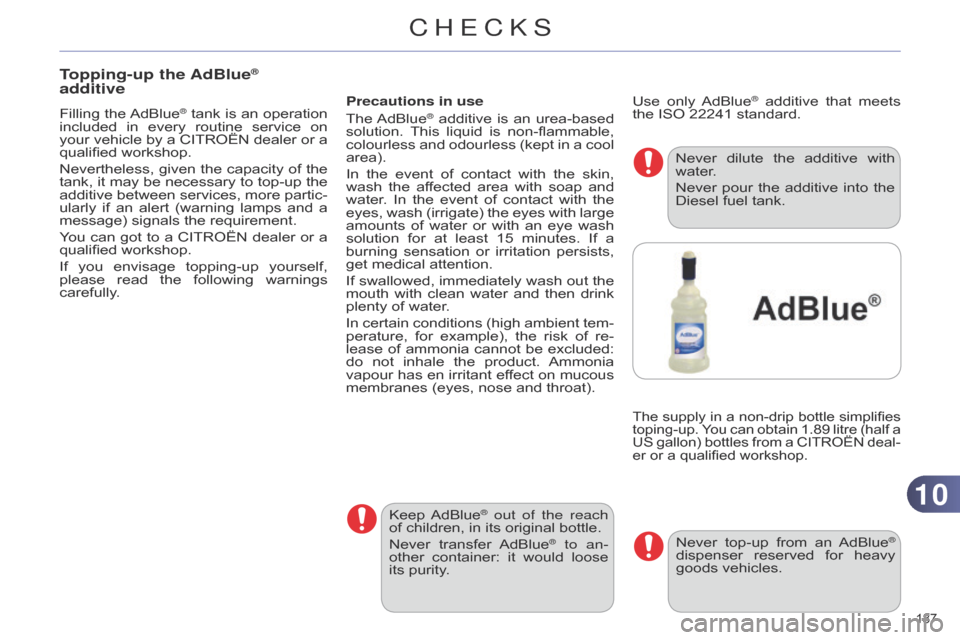
1010
187
C4-2_en_Chap10_verification_ed01-2014
Topping-up the AdBlue®
additive
Filling the AdBlue® tank is an operation included
in
every
routine service on
your
vehicle
by
a
CITROËN
dealer
or
a
qualified
workshop.
Nevertheless,
given
the
capacity
of
the
tank,
it
may
be
necessary
to
top-up
the
additive
between
services,
more
partic
-
ularly
if
an
alert
(warning
lamps
and
a
message)
signals
the requirement.
You
can
got
to
a
CITROËN
dealer
or
a
qualified
workshop.
If
you
envisage
topping-up
yourself,
please
read
the
following
warnings
carefully
. Precautions in use
The
AdBlue® additive is an urea-based solution.
This liquid is non-flammable,
colourless
and
odourless
(kept
in
a
cool
area).
In
the
event
of
contact
with
the
skin,
wash
the
af
fected
area
with
soap
and
water
.
In
the
event
of
contact
with
the
eyes,
wash
(irrigate)
the
eyes
with
large
amounts
of
water
or
with
an
eye
wash
solution
for
at
least
15
minutes.
If
a
burning
sensation
or
irritation
persists,
get
medical
attention.
If
swallowed,
immediately
wash
out
the
mouth
with
clean
water
and
then
drink
plenty
of
water.
In
certain
conditions
(high
ambient
tem
-
perature,
for
example),
the
risk
of
re
-
lease
of
ammonia
cannot
be
excluded:
do
not
inhale
the
product.
Ammonia
vapour
has
en
irritant
ef
fect
on
mucous
membranes
(eyes, nose and throat).
Keep
AdBlue® out of the reach
of
children,
in
its original bottle.
Never
transfer
AdBlue® to an-
other
container:
it
would loose
its
purity. Use
only
AdBlue® additive
that meets the
ISO
22241
standard.
Never
dilute
the
additive
with
water
.
Never
pour
the
additive
into
the
Diesel
fuel
tank.
The supply in a non-drip bottle simplifies toping-up.
Y ou can obtain 1.89 litre (half a
US
gallon)
bottles
from
a
CITROËN
deal-
er
or a qualified workshop.
Never top-up from an AdBlue®
dispenser
reserved
for
heavy
goods
vehicles.
CHECKS
Page 190 of 340
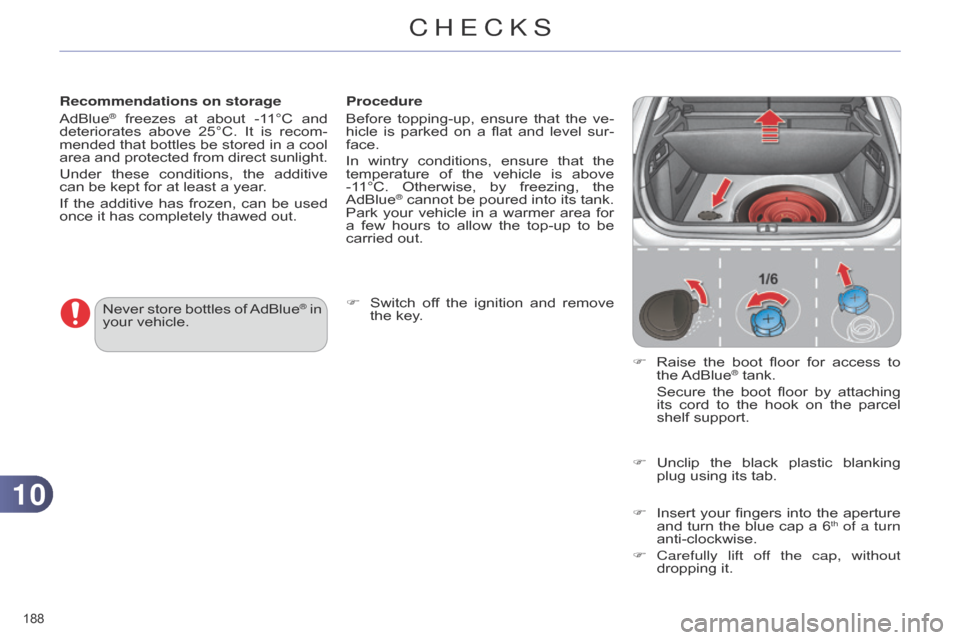
1010
188
C4-2_en_Chap10_verification_ed01-2014
Recommendations on storage
AdBlue® freezes at about -1 1°C and deteriorates
above 25°C. It is recom -
mended
that
bottles
be
stored
in
a
cool
area
and
protected
from
direct
sunlight.
Under
these
conditions,
the
additive
can
be
kept for at least a year.
If
the
additive
has
frozen,
can
be
used
once
it
has completely thawed out.
Never
store
bottles
of
AdBlue® in
your
vehicle. Procedure
Before
topping-up,
ensure
that
the
ve
-
hicle
is
parked
on
a
flat
and
level
sur
-
face.
In
wintry
conditions,
ensure
that
the
temperature
of
the
vehicle
is
above
-1
1°C.
Otherwise,
by
freezing,
the
AdBlue® cannot
be poured into its tank. Park
your vehicle in a warmer area for
a
few
hours
to
allow
the
top-up
to
be
carried
out.
F
Switch
of
f
the
ignition
and
remove
the
key. F
Raise
the
boot
floor
for
access
to
the
AdBlue® tank.
Secure
the
boot
floor
by
attaching
its
cord
to
the
hook
on
the
parcel
shelf
support.
F
Unclip
the
black
plastic
blanking
plug
using
its tab.
F
Insert
your
fingers
into
the
aperture
and
turn
the
blue
cap
a
6th of a turn
anti-clockwise.
F
Carefully
lift off the cap, without
dropping
it.
CHECKS